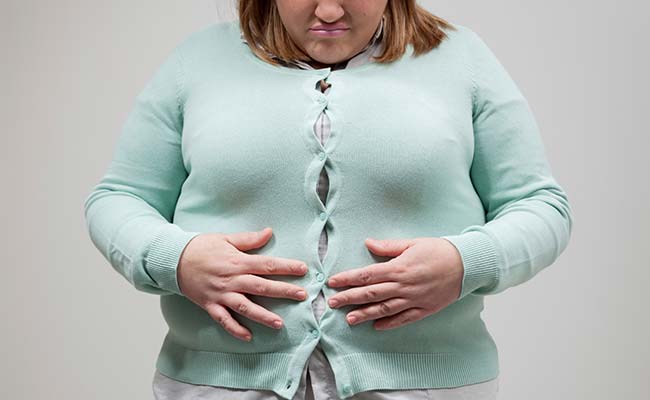Studies have linked obesity to the accumulation of abdominal fat and fat in the liver, making non-alcoholic fatty liver disease (NAFLD) one of the most prevalent diseases of the liver.

Non-alcoholic fatty liver disease (NAFLD) is the term for a wide range of conditions caused by a build-up of fat within the liver cells. It is usually seen in females who are overweight or obese.
|
Prior research has shown that people who are overweight or obese or who have diabetes often have NAFLD. This is also true for people who have high triglycerides or cholesterol. NAFLD means they have steatosis (fat in their cells in the liver), which can lead to steatohepatitis (inflammation and damage to the liver), fibrosis (scarring) and eventual cirrhosis (end-stage liver disease). |
The Role of Liver
The liver is the second largest organ in your body and is located under your rib cage on the right side. The liver performs many jobs in your body. It processes what you eat and drink into energy and nutrients your body can use. The liver also removes harmful substances from your blood.
- It stores glycogen, which is broken down in to glucose (sugar) and released into the bloodstream when the body needs energy
- Helps in processing of fats and proteins
- Helps to remove or process alcohol, drugs and toxins
- Production of bile, which is a fluid that passes through the bile duct to the gut. This is needed to break down digested food into fats
Symptoms
Most NAFLD sufferers has no symptoms and liver disease is often discovered incidentally when laboratory examination shows elevated liver enzyme levels.
When symptoms do occur, they may include
- Fatigue
- Weakness
- Weight loss
- Loss of appetite
- Nausea
- Abdominal pain
- Spider-like blood vessels
- Yellowing of the skin and eyes (jaundice)
- Itching
- Fluid build up
- Swelling of the legs (edema) and abdomen (ascites)
- Mental confusion.
Treatment
Treatment of NAFLD falls into two categories: targeting either the steatosis or the pathogenesis of progression.
- Treatment of steatosis/insulin resistance: The treatment of steatosis is linked to obesity, insulin resistance and dyslipidemia. Factors that decrease steatosis consist of weight loss or pharmacologic therapy directed at insulin resistance or dyslipidemia. The treatment of steatohepatitis is directed at oxidative stress, inflammation and fibrosis. Factors that decrease oxidative stress and inflammation include antioxidants, probiotics, anti-cytokines and glutathione precursors.
- Weight loss: Gradual weight loss is advisable to improve the process in obese patients; rapid loss may worsen NAFLD. Walking or some form of aerobic exercise at least 30–45 minutes daily is recommended.
- Diet Modification: Study (http://www.ncbi.nlm.nih.gov/pubmed/12668986) reported, the dietary intake of NASH patients was richer in saturated fat, cholesterol and was poorer in polyunsaturated fat , fiber, and antioxidant vitamins C and E. A Mediterranean diet (ie, high consumption of complex carbohydrates and monounsaturated fat, low amounts of red meat, and low/moderate amounts of wine) is preferred. However, a low glycemic, low calorie diet with a weight loss of 1–2 kg/wk seems reasonable.
- Surgical Options: Sometimes diet and exercise or medication can help, but those methods lead to a more modest weight loss than with bariatric surgery. With weight loss surgery, a patient can lose 80 to 100 pounds or more.
- Medication: Orlistat is a lipase inhibitor that promotes weight loss by reduction of fat absorption. In a double blind, placebo-controlled trial by Zelber-Sagi et al (2006) randomized 52 patients with NAFLD (diagnosed by ultrasound and confirmed with biopsy) to orlistat or placebo for 6 months. Orlistat decreased aminotransferase levels and reversed fatty liver as determined by ultrasound. Sibutramine, an appetite suppressant, is a serotonin reuptake antagonist approved for weight loss. Both sibutramine and orlistat significantly reduced body weight (10.2 and 8.4%, respectively), insulin resistance (47 and 40%, respectively), AST (41 and 39%, respectively), ALT (59 and 58%, respectively), and GGT serum levels (27 and 25%, respectively).(ref: http://www.ncbi.nlm.nih.gov/pubmed/14502318) . There are currently no specific medicines for NAFLD, but certain medicines used to treat high blood pressure and diabetes also have a beneficial effect on the liver.
- Stop smoking: If you smoke, it’s really important to give up, as this will also help to reduce your risk of heart attack and stroke.
- Stop Drinking: NAFLD is not caused by alcohol, but it may make the condition worse. It’s therefore advisable to stop drinking alcohol.
Simple fatty liver may go away if the underlying cause is tackled. For example, losing excess weight or controlling diabetes better can make fatty liver disappear.
Avoid all processed foods, sodas, sports drinks, junk foods, and trans-fats. Increase omega-3 fatty acids by replacing processed oils (corn, canola, soybean, safflower, sunflower and cottonseed oil) with natural fats (butter, virgin coconut oil, virgin palm oil, lard or beef drippings).
Reference: